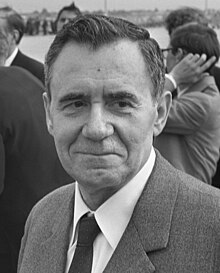Andrei A. Gromyko
| Andrei Gromyko | |
|---|---|

Gromyko in 1972
|
|
|
Chairman of the Presidium of the Supreme Soviet |
|
|
In office 27 July 1985 – 1 October 1988 |
|
| Deputy |
Vasili Kuznetsov Pyotr Demichev |
| Preceded by |
Konstantin Chernenko Vasily Kuznetsov (acting) |
| Succeeded by | Mikhail Gorbachev |
|
First Deputy Chairman of the Council of Ministers |
|
|
In office 24 March 1983 – 2 July 1985 |
|
| Premier | Nikolai Tikhonov |
| Preceded by | Heydar Aliyev |
| Succeeded by | Nikolai Talyzin |
|
Minister of Foreign Affairs |
|
|
In office 15 February 1957 – 2 July 1985 |
|
| Premier |
Nikolai Bulganin Nikita Khrushchev Alexei Kosygin Nikolai Tikhonov |
| Preceded by | Dmitri Shepilov |
| Succeeded by | Eduard Shevardnadze |
| Permanent Representative of the Soviet Union to the United Nations | |
|
In office April 1946 – May 1948 |
|
| Preceded by | Post created |
| Succeeded by | Yakov Malik |
| Full member of the 24th, 25th, 26th, 27th Politburo | |
|
In office 27 April 1973 – 30 September 1988 |
|
| Personal details | |
| Born |
Andrei Andreyevich Gromyko 18 July [O.S. 5 July] 1909 Staryya Hramyki, Mogilev Governorate, Russian Empire |
| Died | 2 July 1989 (aged 79) Moscow, Russian SFSR, Soviet Union |
| Resting place | Novodevichy cemetery |
| Nationality | Soviet |
| Political party | Communist Party of the Soviet Union |
| Spouse(s) | Lydia Dmitrievna Grinevich (1911–2004) |
| Profession | Economist, diplomat, civil servant |
Andrei Andreyevich Gromyko (Russian: Андре́й Андре́евич Громы́ко; Belarusian: Андрэ́й Андрэ́евіч Грамы́ка; 18 July [O.S. 5 July] 1909 – 2 July 1989) was a Soviet communist politician during the Cold War. He served as Minister of Foreign Affairs (1957–1985) and as Chairman of the Presidium of the Supreme Soviet (1985–1988). Gromyko was responsible for many top decisions on Soviet foreign policy until he retired in 1988. In the 1940s Western pundits called him Mr. Nyet ("Mr. No") or "Grim Grom", because of his frequent use of the Soviet veto in the United Nations Security Council.
Gromyko's political career started in 1939 with his employment at the People's Commissariat for Foreign Affairs (renamed Ministry of Foreign Affairs in 1946). He became the Soviet ambassador to the United States in 1943, leaving in 1946 to become the Soviet Permanent Representative to the United Nations. Upon his return to the Soviet Union he became a Deputy Minister of Foreign Affairs and later the First Deputy Minister of Foreign Affairs. He went on to become the Soviet ambassador to the United Kingdom in 1952.
...
Wikipedia
